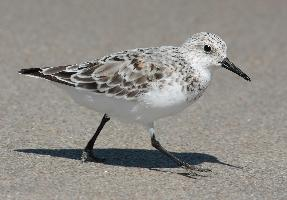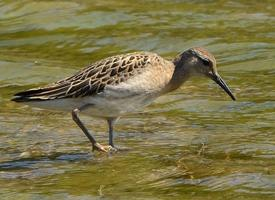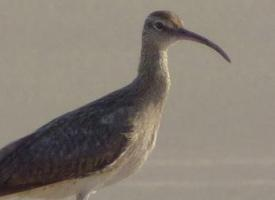
Description de l'animal
The Marsh Sandpiper (Tringa stagnatilis) is a slender, elegant wading bird belonging to the family Scolopacidae, which includes sandpipers, snipes, and their kin. This species exhibits a delicate grace that sets it apart in the habitats it frequents, primarily marshes, swamps, and shallow freshwater bodies across its range. It is a bird of passage for many regions, breeding in the marshes of central and eastern Europe and parts of Asia, and wintering in sub-Saharan Africa, the Indian subcontinent, Southeast Asia, and Australia.Adult Marsh Sandpipers stand at about 20-23 cm tall, with a wingspan that ranges from 55 to 59 cm. They possess a notably slim build and long, greenish legs that are characteristic of waders. Their long, fine, straight bill is perfectly adapted for probing into mud and shallow water for invertebrates and small aquatic creatures, which make up the bulk of their diet.
The plumage of the Marsh Sandpiper is subtle yet refined. During the breeding season, adults feature a pale grey back and wings, with a white underside. The breast may show light streaking, and the head and neck can exhibit a more defined grey pattern. In flight, their wingtips extend beyond their tail, and a white rump is a distinctive feature, contrasting with the otherwise grey tones of their body. Non-breeding adults and juveniles are paler, with the grey tones giving way to a more uniform white and light grey appearance.
One of the most distinctive behaviors of the Marsh Sandpiper is its delicate, tiptoeing movement through shallow waters, often in small flocks, as it forages for food. Its diet consists mainly of insects, small fish, crustaceans, and other aquatic organisms. The bird's feeding technique involves a lot of active movement, as it walks briskly through shallow waters, occasionally stopping to probe the mud with its bill.
Marsh Sandpipers are migratory birds, undertaking long-distance flights between their breeding and wintering grounds. During migration, they can be found in a variety of wetland habitats, from coastal lagoons to inland marshes, where they rest and refuel. Their call, a sharp "chiff-chiff," is often heard during these times, serving as a means of communication among flock members.
Breeding typically takes place in solitary pairs, although loose colonies are not uncommon. The nest is a simple scrape on the ground, lined with vegetation and situated near water. The female lays 3-4 eggs, which both parents incubate. After hatching, the chicks are precocial, able to leave the nest and feed themselves under the watchful guidance of their parents.
The Marsh Sandpiper, with its graceful appearance and delicate foraging methods, is a fascinating species to observe. Despite facing threats from habitat loss and degradation in its breeding and wintering grounds, it remains a common sight in suitable habitats along its migratory routes. Conservation efforts focused on preserving wetland ecosystems are crucial to ensuring the survival of this and many other species that rely on such environments.
Animaux similaires
Nouvelles photos d'animaux
Top 10 des animaux
- Dolphin gull (Leucophaeus scoresbii)
- Japanese macaque (Macaca fuscata)
- Stone loach (Barbatula barbatula)
- Greek tortoise (Testudo graeca)
- Russian tortoise (Testudo horsfieldii)
- Galápagos tortoise (Geochelone nigra complex)
- Diana monkey (Cercopithecus diana)
- Moustached guenon (Cercopithecus cephus)
- Common flying dragon (Draco volans)
- Galápagos penguin (Spheniscus mendiculus)


